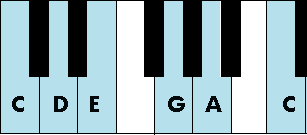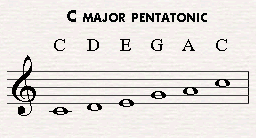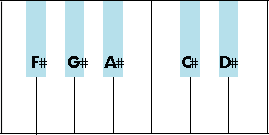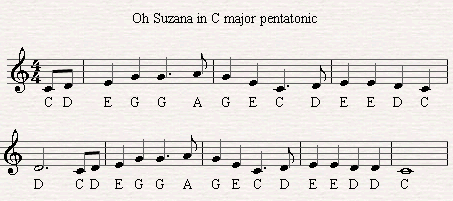The Pentatonic Scale
Home » Piano Theory » The Pentatonic Scale

The pentatonic existed long before the major and minor scale were used in different cultures in the world.
The word "pentatonic" comes from the Greek word pente meaning five and tonic meaning tone.
The scale includes five notes only within an octave unlike the major and minor scales that have seven notes within an octave. The big difference between the pentatonic and the major and minor scale is that the pentatonic contains no semitones.
Let's have a look at C major pentatonic (The minor one will come later).

C pentatonic is made out of these notes: C, D, E, G, A, C which are the 1st,2nd, 3rd, 5th and 6th degrees of the
major scale.
As a matter of fact one can say that the pentatonic is a major scale with out semi tones. The semitones in the major scale have a very active function in the scale leading to the root or the third note of the scale.
The pentatonic however sounds always stable. It is a neural in its character.
That's maybe why the Chinese people have been using this scale forever and still do. Each and every note of the scale is in harmony. That's why it is handy to us in improvisation (We'll talk about it in the future).
Here's a list of all twelve pentatonics according to the circle of fifths.
C pentatonic: C, D, E, G, A, C
G pentatonic: G, A, B, D, E, G
D pentatonic: D, E, F#, A, B, D
A pentatonic: A, B, C#, E, F#, A
E pentatonic: E, F#, G#, B, C#, E
B pentatonic: B, C#, D#, F#, G#, B
Gb pentatonic: Gb. Ab, Bb, Db, Eb, Gb
Db pentatonic: Db, Eb, F, Ab, Bb, Db
Ab pentaotnic: Ab, Bb, C, Eb, F, Ab
Eb pentatonic: Eb, F, G, Bb, C, Eb
Bb pentatonic: Bb, C, D, F, G, Bb
F pentatonic: F, G, A, C, D, F
Click here for a free piano chord chart of all the twelve major pentatonic scales.
 Notice
that if you'll press on the black keys starting from F# be playing the F# major pentatonic which sounds rather chinese in the under statement.
Notice
that if you'll press on the black keys starting from F# be playing the F# major pentatonic which sounds rather chinese in the under statement.
Many melodies are made with the pentatonic scale. The beginning of Oh Susana is a good example.

One of my favorite is "Sir Duke" by Stevie Wonder.

The next scale we're going to learn is the minor pentatonic scale. Click here to go to the minor petnatonic scale page.
Return from The Pentatonic Scale to Piano Theory.














